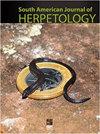Risk of Nest Flooding in a Population of the Magdalena River Turtle (Podocnemis lewyana) Inhabiting the Climatic Equator in Northern Colombia
IF 0.7
4区 生物学
Q4 ZOOLOGY
引用次数: 0
Abstract
Abstract. We quantified nesting activity and incidence of nest flooding in a population of the Magdalena River turtle (Podocnemis lewyana), which inhabits the climatic equator in northern Colombia, during two dry seasons when beaches formed (“verano”—December to March—and “veranillo”—July and August). Nesting activity was concentrated in the verano period, despite the presence of suitable nesting habitat in both dry season periods. More than half of all nests were harvested by local people, and 42.5% of the nests in both dry seasons that survived harvest were subsequently lost to flooding due to rises in the river to approximately a 4.15 m level. We used this value as a threshold value for the appearance of beaches and inspected a 44-year data base on river levels in this area. The verano and veranillo nesting periods did not differ in terms of opportunities for successful nesting, but there was evidence that the veranillo nesting season has increased significantly in duration in recent years, as well as experienced fewer flooding events. It is not clear why nesting each year is principally concentrated in the verano nesting season, but the evidence that this section of the Magdalena River is drying more in recent years during veranillo may entail a new threat to this population if it implies that non-nesting habitat (adjacent wetlands and channels) might eventually disappear.居住在哥伦比亚北部气候赤道地区的马格达莱纳河龟(Podocnemis lewyana)种群巢淹的风险
摘要我们量化了马格达莱纳河龟(Podocnemis lewyana)种群的筑巢活动和巢洪发生率,它们居住在哥伦比亚北部的气候赤道,在海滩形成的两个旱季(“verano”- 12月至3月-“veranillo”- 7月和8月)。尽管两个旱季都有适宜的筑巢生境,但筑巢活动主要集中在干旱期。超过一半的鸟巢是由当地人采摘的,在两个旱季幸存下来的鸟巢中,有42.5%随后因河水上涨至约4.15米的水位而被洪水淹没。我们使用这个值作为海滩出现的阈值,并检查了该地区44年的河流水位数据库。veranillo和veranillo的筑巢期在成功筑巢的机会方面没有区别,但有证据表明,veranillo筑巢季节的持续时间在近年来显着增加,并且经历了较少的洪水事件。目前还不清楚为什么每年的筑巢主要集中在veranillo筑巢季节,但是有证据表明,近年来在veranillo筑巢季节,Magdalena河的这一段越来越干燥,如果这意味着非筑巢栖息地(邻近的湿地和水道)可能最终消失,可能会对这个种群构成新的威胁。
本文章由计算机程序翻译,如有差异,请以英文原文为准。
求助全文
约1分钟内获得全文
求助全文
来源期刊
CiteScore
1.50
自引率
0.00%
发文量
10
期刊介绍:
The South American Journal of Herpetology (SAJH) is an international journal published by the Brazilian Society of Herpetology that aims to provide an effective medium of communication for the international herpetological community. SAJH publishes peer-reviewed original contributions on all subjects related to the biology of amphibians and reptiles, including descriptive, comparative, inferential, and experimental studies and taxa from anywhere in the world, as well as theoretical studies that explore principles and methods.

 求助内容:
求助内容: 应助结果提醒方式:
应助结果提醒方式:


